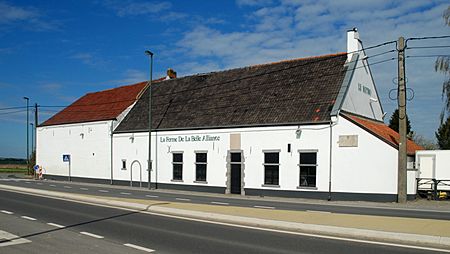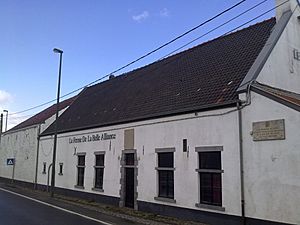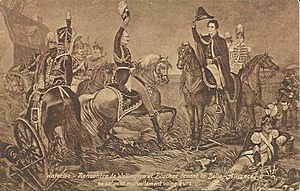La Belle Alliance facts for kids
La Belle Alliance is an old inn (like a small hotel or tavern) located a few miles south of Brussels in Belgium. It is famous because of what happened there after the Battle of Waterloo on June 18, 1815.
You can find two special plaques on the building today. One plaque honors the French Medical Corps. These brave medical teams helped the wounded soldiers with great care on the day of the battle. The other plaque remembers the important meeting between the two winning army leaders right after the Battle of Waterloo ended.
Contents
What is La Belle Alliance Used For Today?
Today, the La Belle Alliance building has a different purpose. On Friday and Saturday evenings, it is used as a night club.
The Battle of Waterloo and Its End
The Battle of Waterloo was a very important battle in history. It ended around 9:00 PM on June 18, 1815. After the fighting stopped, two famous army leaders met near the La Belle Alliance inn. These leaders were Prince Blücher from Prussia and the Duke of Wellington from Britain. Their meeting showed that the battle was truly over.
You can see a large painting of this meeting inside the Palace of Westminster in London. The artist Daniel Maclise painted it in 1861. It shows Blücher and Wellington shaking hands near La Belle Alliance.
Why the Battle is Called Waterloo
After the battle, Prince Blücher, the Prussian commander, had an idea. He suggested that the battle should be named La Belle Alliance. He wanted to remember the strong team of European countries that worked together to defeat the French Emperor. This team was called the Seventh Coalition. It included Britain, Russia, Prussia, the Netherlands, Sweden, Austria, Spain, Portugal, Sardinia, and several German States.
However, the Duke of Wellington had a different idea. He had chosen the battlefield and led the allied army all day. He suggested naming the battle after Waterloo. This was a small village just north of the battlefield. Wellington himself had spent the night before the battle in Waterloo.
Even though Wellington's idea was chosen, La Belle Alliance is still remembered. In 1815, a public square in Berlin, Germany, was renamed Belle-Alliance-Platz to celebrate the victory. There is also a La Belle Alliance Square in Ramsgate, Kent, in the United Kingdom.
Images for kids
See Also







